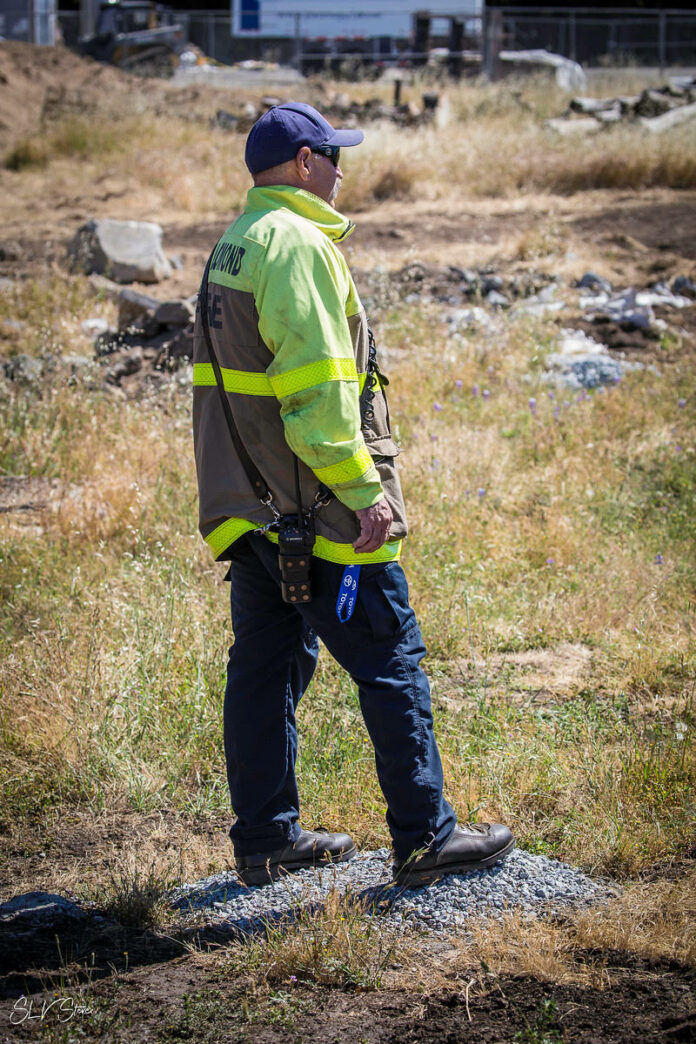
This week’s focus is on the Ben Lomond Fire Protection District (BLFD) personnel, led by Fire Chief Stacie Brownlee and Assistant Chief Mike Ayers, who was interviewed for this article. Chief Ayers has been in the fire service for 39 years. He started with CalFire (formerly the California Department of Forestry) in 198, and was a volunteer with Zayante. In 1986, after moving to Ben Lomond, Ayers joined the Tiburon Fire Protection District, and worked there for 31 years. After retiring as a Battalion Chief with Tiburon, Ayers became a Board member with BLFD, and eventually gave up that seat in order to join the department in a chief officer role. Ayers also runs training and operations for the district.
From Fire Chief Brownlee on down, there are a total of 28 personnel to serve the district, plus another five volunteers eagerly waiting to join the department. Chief Ayers said that those personnel, plus additional townspeople who came out to assist, were pivotal in the success of holding the CZU fire back from town. “At one point, we had 55 people here. We have a lot of guys who live here that are career firefighters elsewhere, and they all came back to help. Retirees (like former Fire Chief Steve Sanders, former Captain Eddie Butler, Robert Sanchez and Jack Muncie) came in, picked up phones and helped administratively,” said Ayers. “The Brumbaugh family came in to cook and take care of laundry for everyone, and ran our resource board. It was definitely a community effort.”
Press Banner: I learned a lot about resource management from interviewing Boulder Creek Fire Chief Mark Bingham. Did Ben Lomond Fire run their response the same way?
Chief Ayers: I’d say it was pretty similar. We rotated people through on 24-hour shifts the first three days. After that, we rotated companies through on 12-hour shifts to allow everyone to get some sleep. The maximum personnel we had out on the line at one time were five engines, one utility vehicle, two chief’s vehicles—so 24 people total. Chief officers mainly stayed out on the fire line, and caught sleep when we could.
PB: Were you deployed in support of CalFire, or was CalFire deployed to support your department?
CA: Our deployment began late on Saturday, August 15th with calls for trees and power lines down due to the lightning storm. I don’t think any of us were thinking we would get fire starts out of it; I’ve seen lightning storms come through before, and we get a tiny fire that burns itself out, but by Sunday, we had an engine assigned to the 3-11 Fire. As soon as you hear that, you know that CalFire is assigning numbers because it’s a complex fire—the number three is CalFire’s number for the Zayante area, and the number 11 means there are at least 11 active fires. The engine company stayed out on Sunday and Monday, and halfway thru our Tuesday night drill (on August 18th), we were dispatched as a strike team for structure protection to Boulder Creek. Two engines wound up there, and they were there for two days. All the chief officers for Boulder Creek were tied up, so I was running coverage for both districts, and then I acquired a task force of Boulder Creek resources for managing spot fires and other incidents. Our engines, along with Dalton Warren from Zayante Fire, were assigned structure protection duties under Boulder Creek Captain Gabe Vega.
The weird thing about this fire is how personal it was. I’ve responded to other big fires around the region, and when you’re deployed, it’s all business. You do your job and return home. Here, the fire was in our home town, so when you’re responding to a spot fire, it may be at the home of someone you know. It’s a totally different experience. There was a big emotional investment in this incident, because many of us knew people—including firefighters—who were affected by it. The parents of one of our firefighters lost their home, but our firefighters were all spared. At one point, we were up on Braemoor Drive, assessing when the fire was going to impact Ben Lomond. We arrived right after the engines had pulled out, and saw the home of another one of our firefighter’s parents. The deck was burning, so we pulled out some chainsaws and went to work doing structure protection. CalFire ended up cutting a bulldozer line behind the home to stop the fire’s advancement, and the home was saved as a result.
PB: It sounds like a fire of this magnitude creates a real need for responding agencies to have great communication and teamwork with each other. How do you remain focused on what you need to do and not get distracted with all the other chatter?
CA: On the 19th, our Ben Lomond team met with Shawn Norman, the CalFire Operations Deputy Chief. From Wednesday, August 19th thru Thursday, August 20th, the fire grew 43,000 acres. We discussed the impact of the fire. We already knew about the limited resources available via CalFire; my five top responders are seasonal firefighters with CalFire, and they were all serving under that agency. Several complex fires had all broken at the same time, so we were competing with other large incidents for resources. Norman and I spoke about what had happened with the Camp Fire in Paradise, so we had a contingency for Ben Lomond proper. Our idea was to get up the mountain and stop the fire there in order to protect the Highway 9 corridor. We always had one engine here on patrol, because the fire spotted pretty far out. We had pieces of singed redwood bark and burnt leaves coming down here, so we knew the fire was throwing debris ahead of itself. A lot of our response plan hinged on what happened in Boulder Creek; if we kept it west of the mountain, that was our best option. We kept communicating with CalFire, even before the unified command came into play.
The fires that merged together along the top of the ridge created a large fire by most measures—5,000 acres—but especially for Santa Cruz County.
PB: How close did the fire get to downtown Ben Lomond?
CA: The fire burned in fingers along the drainages. A lot of people drive down Highway 9, look up at Bonny Doon, and they imagine one slope that runs up the mountain, but there are intermediate ridges and valleys all along that area. When I flew the fire the following week, you could see where the fire had moved through various drainages along the mountain, and fed downward. That’s how the fire moved into our district—in pieces and parts. Thursday morning at 2am we had a spot fire on Upper Alba Road—about an acre—threatening two homes in heavy timber. We thought we had a handle on it, but then it came across Alba drainage and took several homes with it. We had already done prep work around the homes, so we tried to manage it, but it came out of the Clear Creek drainage further down and crossed over and took the Alba Schoolhouse. When it emerged, it was almost a crown fire at that point. We had three different types of fire: during the day it was creeping, staying in the duff (the layer of decomposing organic materials lying below the litter layer of freshly fallen twigs, needles, and leaves and immediately above the mineral soil), which was a few feet thick in some places, with 1-2 foot flame lengths. At night, the same fuels were burning but the fire was moving up the trees, and we’d see 12-15 foot flame lengths where the fire was moving up the trees and torching them, and if enough trees were close together, we would get a crown fire which can run faster than we could move. It was strange fire behavior, and always more intense at night. The first five nights the marine layer held the smoke in, creating terrible visibility. People would ask me why helicopters weren’t coming in with water drops, since they have night vision. They do have night vision, but they need to maneuver the bucket over the trees to make a drop, and they just couldn’t see the tree canopy to make an effective run at it, so they stopped flying after 7:30pm. About a week into the fire, we started getting helicopters, and that really helped.
Next week: Lessons learned in the CZU August Lightning Complex Fire












